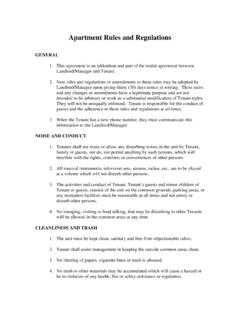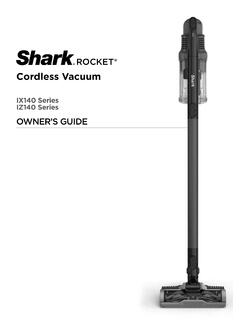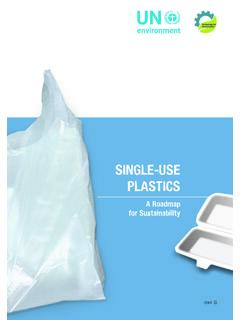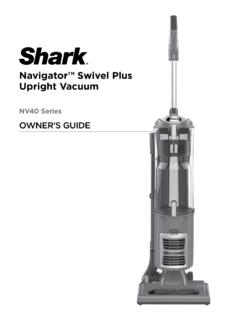Transcription of DNA EXTRACTION METHODS - Open University of Sri Lanka
1 DNA EXTRACTION METHODS Yatawara Department of MLS, FAHS How Can We Recover DNA From a Variety of Sources of Biological Evidence? Blood Semen Saliva Urine Hair (w/Root & Shaft) Teeth Bone Tissue cigarette butts Envelope & Stamps Fingernail Clippings Chewing Gum Bite Marks Feces What are the essential components of a DNA EXTRACTION Procedure? DNA recovery inhibitors or inhibit nucleases the quality of DNA strand vs. Single strand (RFLP or PCR) How Much DNA Can We Recover A Diploid Cell contains approximately 6 pg of DNA Sperm contains approximately 3 pg of DNA The average WBC of an adult is 5 - 10 X 106 cells per ml of blood. Therefore, the theoretical recovery of DNA per ul of blood is 30 - 60 ng.
2 How Much DNA Do We Need? The PCR reactions call for on average 1 ng of DNA (single or double stranded). This is the equivalent of 1/20 of 1 ul of blood, or 350 sperm. Many of the commercially available kits are sensitive below 1 ng of DNA (100-250 pg). How Much DNA Do We Need? The RFLP procedure on requires a minimum of 50 ng of high molecular weight double stranded DNA. This is the equivalent of approximately 2 ul of blood. The number of intact sperm ( 3 pg/sperm) is approximately 20,000. What are the Most Commonly used DNA EXTRACTION Procedures in Forensic Science? Organic (Phenol-Chloroform) EXTRACTION Non-Organic (Proteinase K and Salting out) Chelex (Ion Exchange Resin) EXTRACTION FTA Paper (Collection, Storage, and Isolation) Silica Based (Silica exchange resin- Qiagen) The method utilized may be sample dependant, technique dependant, or analyst preference ORGANIC EXTRACTION Perhaps the most basic of all procedures in forensic molecular biology is the purification of DNA.
3 The key step, the removal of proteins, can often be carried out simply by extracting aqueous solutions of nucleic acids with phenol and/or chloroform. ORGANIC EXTRACTION PROCEDURE Cell Lysis Buffer - lyse cell membrane, nuclei are intact, pellet nuclei. Resuspend nuclei, add Sodium Dodecly Sulfate (SDS), Proteinase K. Lyse nuclear membrane and digest protein. DNA released into solution is extracted with phenol-chloroform to remove proteinaceous material. DNA is precipitated from the aqueous layer by the additional of ice cold 95% ethanol and salt Precipitated DNA is washed with 70% ethanol, dried under vacuum and resuspended in TE buffer. ORGANIC EXTRACTION REAGENTS Cell Lysis Buffer - Non-ionic detergent, Salt, Buffer, EDTA designed to lyse outer cell membrane of blood and epithelial cells, but will not break down nuclear membrane.
4 EDTA (Ethylenediaminetetraacetic disodium salt) is a chelating agent of divalent cations such as Mg2+. Mg2+is a cofactor for Dnase nucleases. If the Mg2+is bound up by EDTA, nucleases are inactivated. ORGANIC EXTRACTION REAGENTS Proteinase K - it is usual to remove most of the protein by digesting with proteolytic enzymes such as Pronase or proteinase K, which are active against a broad spectrum of native proteins, before extracting with organic solvents. Protienase K is approximately 10 fold more active on denatured protein. Proteins can be denatured by SDS or by heat. ORGANIC EXTRACTION REAGENTS Phenol/Chlorform - The standard way to remove proteins from nucleic acids solutions is to extract once with phenol, once with a 1:1 mixture of phenol and chloroform, and once with chloroform.
5 This procedure takes advantage of the fact that deproteinization is more efficient when two different organic solvents are used instead of one. Also, the final EXTRACTION with chloroform removes any lingering traces of phenol from the nucleic acid preparation. Phenol is highly corrosive and can cause severe burns. ORGANIC EXTRACTION REAGENTS Phenol - often means phenol equilibrated with buffer (such as TE) and containing hydroxyquinoline and b-mercaptoethanol (added as antioxidants. The hydoxquinoline also gives the phenol a yellow color,making it easier to identify the phases (layers). Chloroform - often means a 24:1 (v/v) mixture of chloroform and isoamyl alcohol. The isoamyl alcohol is added to help prevent foaming.)
6 The Phenol/Chloroform/Isoamyl Alcohol ratio is 25:24:1 Concentrating DNA Alcohol Precipitation The most widely used method for concentrating DNA is precipitation with ethanol. The precipitate of nucleic acid, forms in the presence of moderate concentrations of monovalent cations (Salt, such as Na+), is recovered by centrifugation and re-dissolved in an appropriate buffer such as TE. The technique is rapid and is quantitative even with nanogram amounts of DNA. Concentrating DNA Alcohol Precipitation The four critical variables are the purity of the DNA, its molecular weight, its concentration, and the speed at which it is pelleted. DNA a concentrations as low as 20 ng/ml will form a precipitate that can be quantitatively recovered.
7 Typically 2 volumes of ice cold ethanol are added to precipitate the DNA. Concentrating DNA Alcohol Precipitation Very short DNA molecules (<200 bp) are precipitated inefficiently by ethanol. The optimum pelleting conditions depend on the DNA concentration. Relatively vigorous microcentrifuge steps such as 15 minutes at or below room temperature at 12,000 rpm are designed to minimized the loss of DNA from samples with yields in the range of a few micrograms or less. Concentrating DNA Alcohol Precipitation Solutes that may be trapped in the precipitate may be removed by washing the DNA pellet with a solution of 70% ethanol. To make certain that no DNA is lost during washing, add 70% ethanol until the tube is 2/3 full.
8 Vortex briefly, and recentrifuge. After the 70% ethanol wash, the pellet does not adhere tightly to the wall of the tube, so great care must be taken when removing the supernatant. Concentrating DNA Alcohol Precipitation Isopropanol (1 volume) may be used in place of ethanol (2 volumes) to precipitate DNA. Precipitation with isopropanol has the advantage that the volume of liquid to be centrifuged is smaller. Isopropanol is less volatile than ethanol and it is more difficult to remove the last traces; moreover, solutes such sodium chloride are more easily coprecipitated with DNA when isopropanol is used. Concentrating DNA Microcon 100 Centrifugal Filter Unit Concentrating DNA Microcon 100 Centrifugal Filter Unit Excellent recovery of DNA samples with recoveries typically > 95%.
9 Ideal for dilute (ng/mL to g/mL range) of DNA solutions Concentrating and purifying proteins, antibodies and nucleic acids (alternative to EtOH precipitation) Desalting and buffer exchange Removal of primers, linkers and unincorporated label Concentrating DNA Microcon 100 Centrifugal Filter Unit Patented deadstop allows for reliable and reproducible concentrate volumes Inverted spin method of concentrate retrieval maximizes recovery Low-binding Ultracel-YM membrane with 100,000 NMWL (Nominal Molecular Weight Limit) cut-off Convenient sample storage of filtrate or concentrated sample in standard microfuge collection tube Use in standard mL tube fixed-angle rotors Resuspension and Storage of DNA TE Buffer - Tris-EDTA Buffer: 10 mM Tris-HCl pH , 1 mM EDTA, or TE-4 which is 10 mM Tris, mM EDTA.
10 DNA is resuspended and stored in TE buffer. DNA must be stored in a slightly basis buffer to prevent depurination, and the EDTA chelates any Mg2+ helping to inactivate DNases. DNA can be stored at 4oC for extended periods, however for long term storage, - 20oC is usually utilized. Avoid repetitive freeze thawing of DNA, since this can cause degradation. The storage of DNA at 4C is better than -20C and storage at room temp dried with stabilizer is even better (Lee et al. 2012) Organic EXTRACTION Pros: yields relatively pure, high molecular weight DNA DNA is double stranded good for RFLP Cons: Time consuming Requires sample to be transferred to multiple tubes increases risk of contamination Involves use of hazardous (and smelly!)









